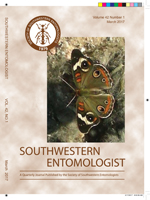Onion thrips, Thrips tabaci Lindeman, a primary insect pest of onions, Allium cepa L., worldwide, reduces yield and transmits a devastating Tospovirus, Iris yellow spot virus. Costly and frequent insecticide application and increased resistance of onion thrips to insecticide prompted interest in alternative pest management options. Three trap crops, lacy phacelia (Phacelia tanacetifolia Benth.), buckwheat (Fagopyrum esculentum Moench.), and carrot (Daucus carota L.) planted in commercial onion fields during two growing seasons were evaluated for attractiveness to onion thrips. Abundance of thrips adults, larvae, and eggs were monitored on trap crops and onion plants, and dispersing adults were counted on aerial traps 0, 0.8, 6.4, and 12.8 m from trap crop rows. All trap crops when flowering or with lush vegetation supported all life stages of onion thrips during at least 1 of 2 years; trends in preference by onion thrips varied. Incidence of Iris yellow spot virus was low ranging from 6.6 to 8.2% in year 2; however, in late September of the second year, incidence was greater near trap crops than at farther distances, as measured by enzyme-linked immunosorbent assay (ELISA). Trap crops were attractive to onion thrips adults in June and July which suggests promise for decreasing numbers of thrips on onion during critical periods of bulb sizing and spread of Iris yellow spot virus; however, the short distance of influence suggested need for larger plot sizes or better sampling methods. Potential for planting trap crops along field edges to attract migrating adult thrips early in the season is discussed.
How to translate text using browser tools
1 March 2017
Trap Crops in Onion to Reduce Onion Thrips and Iris Yellow Spot Virus
K. R. Buckland,
D. G. Alston,
J. R. Reeve,
C. Nischwitz,
D. Drost
ACCESS THE FULL ARTICLE

Southwestern Entomologist
Vol. 42 • No. 1
March 2017
Vol. 42 • No. 1
March 2017




